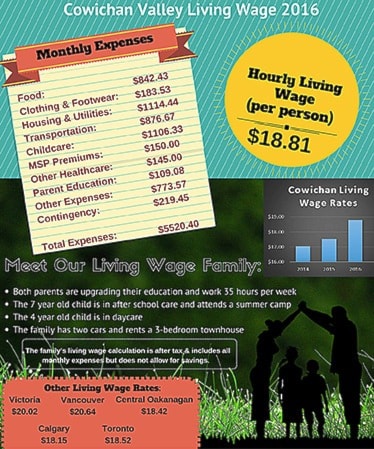What would happen if a couple trying to support themselves and two kids on minimum wage suddenly found they were making a “living wage”?
“They’d be taking home $34,777 more annually,” according to Social Planning Cowichan’s Summer Goulden, with an hourly income of $18.81.
“We just made that calculation yesterday. It’s an enormous difference. It really puts it into perspective. That’s an income in itself,” she said.
Goulden is coordinator of the Living Wage project at SPC.
The most recent figures were released last week.
As expected, housing costs are high in the Valley, exacerbated, as they are in many communities, by a shortage of affordable rental accommodation.
Another problem facing Valley residents is the cost of childcare.
“That’s really interesting, especially when compared to the two previous living wage reports we’ve done. Childcare costs are more reflective of the reality now,” Goulden said.
“They include what summer care would look like. But still they don’t show the costs for a family with a very young child or with more than two children. It would be a lot more as well. And there is finding something that works for your family and places that have vacancies,” Goulden said.
“And on top of that, an interesting thing to see this year was food prices. The BC Food Report was saying that B.C. families might spend an additional $345 on food this year. Food is becoming a lot more expensive and that’s one of the things that has gone up pretty consistently throughout the years.”
At Duncan Day on July 16, Social Planning Cowichan got a chance to talk with members of the public about the findings.
“I myself talked to a few mothers. They said our food pricing wasn’t reflective of what they were actually spending on food because they had quite a few children. They said our number was quite low.”
Parents also pointed out that using government figures doesn’t show the costs involved when people follow the popular local practice of buying food directly from farmers, Goulden said.
“Quality over quantity is such a strong movement, but it’s tough that when you’re going organic, it’s a lot more expensive. It really limits people’s ability to eat healthy sometimes, or makes them sacrifice in other areas,” she said.
“The people who came by [July 16] were really shocked at the difference between the minimum wage and how much it actually costs to live here and employers’ ability to pay a living wage.”
Now that Social Planning Cowichan has this information, the next step is to talk with employers.
“We’re hoping to encourage employers in the Valley to pay a living wage by showing them the problems families face, and also showing them the benefits that a business can have by paying employees a living wage. Those include a lower employee turnover rate, lower levels of stress, fewer employees working two jobs to make ends meet. It would mean overall a better staff,” Goulden said.
lexi.bainas@cowichanvalleycitizen.com
